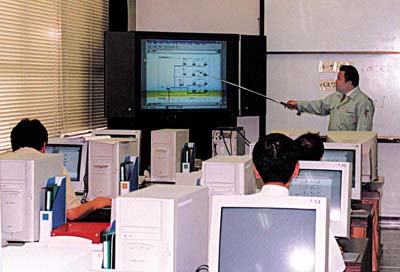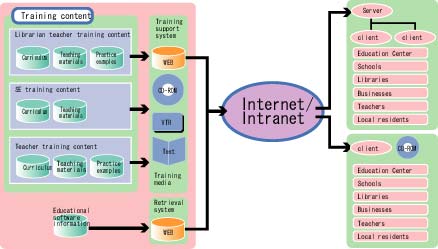Networked Learning
After World War II, the Japanese education system was reformed, modeled after the American school system.
The Japanese school system consists of six compulsory years of elementary school, followed by three compulsory years of junior high.
Those students who wish to continue their education then attend three years of senior high school and four years of university or two years of junior college.
Over 90% of all students also graduate from high school and over 40% from university or junior college.
The percentage of male students is higher at universities than that of female students while the opposite is true at junior colleges.
The Japanese school year starts in April.
It consists of three terms, separated by short breaks in spring and winter.
The summer break for students is one-month long.3.1
One defining characteristic of the Japanese school system is entrance exams, which in turn brings about high competitiveness among students.
Most high schools, universities, as well as a few private junior high schools and elementary schools require applicants to write entrance exams.
Many students attend special preparation schools (juku) besides regular classes in order to pass entrance exams to the best institutions.
The most prestigious universities in Japan are the University of Tokyo and University of Kyoto.3.1
Access to Information and Communication Technologies in School (Stage 4)
According to a survey conducted in 2000, 99.3% of Japanese schools utilized computers - out of the total 39,096 schools in Japan, 38,829 had computers in the school, up from 38,637 (98.6%) in the previous year.
The number of computers in use at all schools in Japan totaled 1,103,862, up from 962,107 in 1999.
However, this study shows that the lower level schools have just a bit of catching up to do to have all schools with computers.
For example, 98.9% of elementary schools have computers in their schools, while junior high and high school levels are at 100%.
This study also illustrates the fact that there are more computers in use at the higher levels in the educational system.
There is an average of 81.9 computers in Japanese high schools, while the number of computers in elementary schools was 15.7.
Internet connectivity in Japanese schools was also listed in this 2000 study.
57.4% of schools were connected to the Internet, up from 35.6% the previous year.3.2
The quality and speed of connectivity for the educational system in Japan is of great concern to the Japanese government.
A project was launched in May 2002 under the banner Broadband School Consortium - an organization consisting of major international technology firms such as Microsoft, NEC, and HP.
This project's mission is to equip all Japanese schools with wireless local-area networks in order to provide broadband access for students to the Internet via notebook computers.3.3
Japan is at Stage 4 in terms of their School System's access to ICTs.
Computers are provided to classrooms at all levels in the educational system, and the schools are provided with access to the Internet as well as to their own national school network.
Japan is taking a proactive role in ensuring their students have access to the latest technologies to assist them in furthering their education.
Enhancing Education with Information and Communication Technologies (Stage 4)
Japan has taken an active role in highly evolving its educational system to harness the abilities of computers and the internet within it's schools, at all levels, from elementary to college.
A major push to computerize the educational system took place in the mid-1980s, with the formation of the CEC as the culmination of those efforts.
The Center for Educational Computing (CEC) organization was founded to further develop educational computing in their country.
This organization is jointly controlled by the Ministry of Education, Culture, Sports, Science, and Technology as well as the Ministry of Economy, Trade and Industry.3.2
It conducts research and development projects as well as surveys that help promote a higher integration of computer use in Japanese schools.
Another organization Japan has formed to further development in the use of technologies in the school system is the National Institute of Multimedia Education (NIME).
It functions as a central institution for promoting the use of multimedia in higher education.
NIME is currently providing institutions of higher education with research and development concerning the application of information communications technology (ICT) in the educational system, such as communications satellites and the Internet.3.4
These initiatives by the CEC and NIME have proven successful.
Two projects were undertaken to enable Japanese schools to communicate via Internet technologies, both of which were started in 1994.
MediaKids is an educational project to facilitate children's inter-school communication via computer network.3.5
The majority of participants are students of elementary schools, junior high schools, high schools and alternative and special education programs in Japan.
The project is conducted by GLOCOM and other supporting organizations.
Launched by the CEC, the 100-School Networking Project consists of servers and client computers, which are installed at about 100 elementary, junior high and senior high schools throughout Japan, are connected to the Internet in order to provide an environment that permits joint classroom exercises, information exchange and network conferencing through use of the network.3.2
Software is also provided for enabling students to access and send their information to libraries and schools throughout the world.
The 100-School Networking project results were then expanded on by the CEC to extend Internet connectivity to the entire Japanese school system - this project is entitled E square.3.2
Thousands of Japanese schools at all levels now have their own web sites.
All these projects are successful in networking the Japanese school system, and providing a way for the students to utilize the newest technologies while at the same time allow study beyond the restrictions of the traditional classroom.
Japan has been actively increasing the computer operating skills of teachers.
As of 2002, the computer operation capabilities of teachers in Japan average 85.46%.
For example, at the elementary schools level 84.6% of teachers are able to operate computers.
At the junior high level 85.0% of teachers can operate computers, and at the high school level, 86.8% of teachers can operate computers.3.2
The number of teachers in Japan who are able to provide instruction in computer skills was 31.8% in March of 2001, up from 26.7% the prior year.3.2
As of January 2003, all high schools students will be required to take a course in Information Technology3.6
In terms of it's progress in enhancing education with ICTs, Japan is at a Stage 4.
Japan is proactive in terms of fully integrating information and communication technologies into the school system.
The projects undertaken in Japan have provided Japanese students with the ability to collaborate among different schools on activities.
A proactive stance in the education of Japanese teachers has been taken, with more and more teachers able to utilize the newest technologies.
Developing the Information and Communication Technologies Workforce (Stage 3/Stage 4)
Japanese higher educational institutions offer a wide range of schooling in Information and Communication Technologies.
Large universities such as the University of Tokyo offer this type of education.
There are also colleges dedicated specifically in the education of students in ICTs, such as the Tokyo Institute of Technology.
As of 2000, Japan's colleges of technology totaled 57.3.4
First established in 1962 to meet the demands of Japan's progress in technology, the colleges of technology were founded to provide education and training for engineers in a system different than the University system.3.7
The CEC is also developing a training program and education materials in order to promote the use of computers and the Internet in classroom teaching.
This program is aimed to assist the teachers, as well as to train the librarians and system engineers who support the teachers.
CEC is also developing a training support system that will enable remote training via networks, as well as an educational software information retrieval system.3.2
The Japanese Government is also funding the Information and Communication Technology Portal for Teacher Training.
This portal will provide a gateway to Internet resources and websites dedicated to training the teachers in utilizing information and communication technologies to enhance their teaching skills.3.8
A variety of training opportunities are available in Japan to further knowledge in Information and Communication Technologies.
This training includes advanced courses available at universities, onsite company training provided by independent vendors such as Professional Training Services and New Horizons Japan, as well as computer based training, such as NETG courses.
More than 40% of Japanese companies provide education in IT to their employees, a number which should be rising in the coming years.
More importantly, in 2002 the Japanese Ministry of Public Management, Home Affairs, and Telecommunications implemented the Information and Communications Personnel Training Support System, which will propel Japan's position in becoming a leading resource country for IT personnel by training people who posess technical knowledge and skills in the rapidly advancing information and communications field.3.9
Overall, Japan has many opportunities for the continued education of the ICT workforce.
The people of Japan have access to specialized training and education in ICT can be undertaken at the university level as well as at specialized colleges of technology.
Japan needs to continue to offer specialized training, but also promote this education to all segments of the population, especially where it is lacking.
Japan is transitioning from Stage 3 to Stage 4 in developing the ICT workforce.

